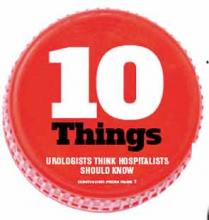10 Things Urologists Think Hospitalists Should Know
10 Things: At A Glance
- Take out urinary catheters as soon as possible.
- But don’t carry the Choosing Wisely directive on urinary catheters—and in-house protocols—too far.
- Beware certain types of medications in vulnerable patients.
- Don’t discharge patients who are having difficulty voiding.
- Broach sensitive topics, but do so gently.
- Call in a urologist, or someone with more experience, when you have difficulty placing a catheter.
- Diabetic patients require extra attention.
- Practice good antibiotic stewardship.
- Determine whether the patient can be seen as an outpatient.
- Embrace your role as eyes and ears.
1: Intravenous Haloperidol Does Not Prevent ICU Delirium
Urology is an area in which hospitalists might not have much formal training, but because many of these patients undergo highly complicated surgical procedures with great potential for complications, hospitalists can be vital for good outcomes, urologists say.
The use of urinary catheters is a prime area of concern when it comes to quality and safety, making hospitalists’ role in the care of urological patients even more crucial.
The Hospitalist spoke with a half dozen urologists and well-versed HM clinicians about caring for patients with urological disorders. Here are the best nuggets of guidance for hospitalists.
Take out urinary catheters as soon as possible.
John Bulger, DO, FACOI, FACP, SFHM, a hospitalist and chief quality officer at Geisinger Health System in Pennsylvania, says that, all too often, urinary catheters are left in too long. “There’s pretty good data to suggest that there’s a very direct relationship with the length of time the catheter’s in and the chance of it getting infected,” he says. “Upwards to half of the urinary catheters that are in in hospitals right now wouldn’t meet the guidelines of having a urinary catheter in.”
Dr. Bulger is chair of SHM’s Choosing Wisely subcommittee. One of SHM’s Choosing Wisely recommendations warns physicians not to place, or leave in place, catheters for incontinence, convenience, or monitoring of non-critically ill patients.1
2: But don’t carry the Choosing Wisely directive on urinary catheters—and in-house protocols—too far.
William Steers, MD, chair of urology at the University of Virginia and editor of the Journal of Urology, says there are risks associated with taking catheters out when it’s not appropriate, especially in patients who’ve undergone surgery.
“We’ve seen situations where we’re called into the operating room by another team,” Dr. Steers says. “Let’s say there was a bladder injury of another service. We’ve repaired the bladder with a catheter in for seven to 10 days. It’s taken out day one; the bladder fills and has the potential of causing harm.”
Early removal before the bladder wall heals can cause bladder rupture, requiring emergency surgery.
“So the devil’s in the details,” he says.
Mark Austenfeld, MD, FACS, president of the American Association of Clinical Urologists, which is dedicated to political action, advocacy, and best practice parameters, says catheters should remain in place for patients with mental status changes, or those who are debilitated in some way and can’t get out of bed or don’t have the wherewithal to ask for help from a nurse.
He says he realizes hospitalists are following pay-for-performance protocols, but he adds a caveat.
“Many times these protocols cannot take into account all of these specialized situations,” says Dr. Austenfeld, a urologist with Kansas City Urology Care. He stresses, though, that the hospitalists he’s worked with do high-quality work.
Sanjay Saint, MD, MPH, FHM, hospitalist and professor of internal medicine at the University of Michigan in Ann Arbor, says that even with these issues, early removal should remain a priority when appropriate.



